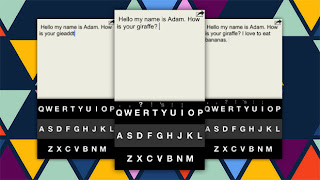Fleksy: Can a New Keyboard Live Up to Its Name?
 |
| Fleksy Keyboard |
A few years ago, Bill
Gates declared that the “keyboard and mouse are dead”. At the time he was
referring to the advent of voice recognition, touch and gesture as a way of
entering data. In practice its not been quite as simple as that, perhaps
because the traditional PC has entered a period of decline, and is rapidly
being replaced by a whole new generation of technologies in the form of
smartphones and tablets.
Some of what Gates foresaw has come true, Siri on iPhone,
along with touch on tablets has left us with little use of a mouse for these
new devices, but the keyboard is still important. Its interesting to see that
the new Windows 8 slates come with a keyboard, Bluetooth keyboards are
available for iPads and Android Tablets, but for many people it still the on
screen keyboard that offers the most used way of writing on a phone or tablet.
From the very beginning of the growth of the new devices,
those on screen keyboards were a problem. Whole websites were created to
present the funny things that word prediction came up with, many of which still
circulate on facebook, and the keyboards themselves were often frustrating for
those with a form of tremor or physical need as they required a high degree of
touch accuracy for success.
Reinventing the keyboard has been a subject of a number of
interesting projects over the years. Replacing the keyboard with morse code
entry was one approach, “Dasher” where the predicted letters “flew” towards you
on screen was another.
Most recently “Swype” a keyboard where you used your
finger to glide between letters to create words, rather than tapping at them
individually, was very widely used and in fact held the record for the fastest
text messaging solution for some time. But at CSUN in San Diego a new product
was being demonstrated and used by a lot of the delegates I met.
Fleksy is without doubt a great example of an innovation,
and effort to “reinvent the wheel” which actually gives us a better wheel. It
has a very simple premise, when we type we type words in patterns, those
patterns are often quite distinct combing numbers of letters with location on a
preset grid or keyboard layout. Taking this as its starting point, it allows
you to start typing, typing at speed, on the keyboard provided. Don’t look at
what you are typing, just keep going, and Felksy recognizes the patterns of
touches you are making and converts those into words. Its possibly the first
real touch typing app for mobile devices.
And it works amazingly well, coupled with a pretty smart
word prediction tool, and some voice output it allows you to type really
quickly, it’s a hundred times more effective than the build in keyboard on my
iPhone and within 5 minutes of using it I was sold!
At CSUN I was clearly not
the only one who has bought into this either, and those people using Fleksy
included people with tremor (its very forgiving of slight variations in
keypresses) People with Dyslexia (the gestures plus prediction mean you don’t
have to look at the leters and words as they form) and people who were blind.
The combination of swipe gestures with voice output makes this a great form of
input for people with little or no sight.
So everyone was very excited, but a problem still exists. In
this case its to do with Apple.
Apple will not allow you to replace their
keyboard with Fleksy, which means that when you open your email and hit “reply”
the Apple keyboard is still the default. Which is frustrating, when you have better
option installed. Instead you have to open Fleksy, type your message and then
send the text to an app. Once you are in that app then you are back to Apples
keyboard. That really irritating and an example of how Apple’s tight ecosystem
can stifle innovation rather than facilitate it.
I guess at some point this will change, or we may only end
up with a fully functioning, usable Fleksy on Android or Windows, only time
will tell. But until then, download Fleksy (its free) and start to explore – I
promise you will never want to use anything else – at least not this week
!
Mr David Banes, Mada CEO
March 2013.
No comments:
Post a Comment